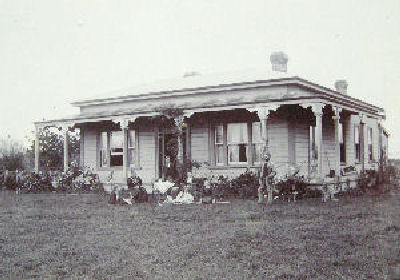It was a bit of a mystery exactly where this school was!
According to recollections from old boys printed in a newspaper in 1949 the school would have been quite near to the old Methodist Chapel.
This was built on a very old Quaker burial ground and is now a private house, named 'The Old Chapel' and is situated on the corner of Edgemoor Road and Combeland Road in Alcombe.
The little chapel was beyond the schools playground and there was a walnut tree in the lower garden behind the old Methodist chapel and an orchard adjoined the garden. A door at the end
of the garden provided an easy way to Mr Adams' tuck shop!
Its possible that the location of the school was Hoar Oak House. It's referred too as being 'behind' the Britannia Inn and as being in Combeland Road. None of the 'recollections' actually state exactly where it was.
Through census research in each of the decades between 1851 and 1891 the Mildon school is always the first entry after the Britannia Inn. Even though the Inn itself did not extend in those days,
right to the Combeland Road corner, a non-residential building of some kind did form an extension to the corner. The census entries that immediately follow the Mildon school are cottages that go by the names 'The Cote' and then 'Rose Bank Villa'.
By 1901 there are two further addresses entered between the Britannia Inn and the school. What was probably the Mildon school is described now as the OLD School House, which is now workmens tenements, possibly the old school room and boarding accommodation. The next entry, dittoed for the Old School House is now a private address.
Another School was opened on the same road a few doors along, and in 1901 the teachers were: Edward Weston aged 55 schoolmaster and Richard W.Thomas aged 34, assistant schoolmaster.
By 1912 the tutor was Richard Hewett. My 1910 residents list shows Richard W.T.Hewett (tutor) living at The School House. Then we have the OLD school house which is now, The workmens tenaments, housing Llewellyn Hunt, Henry Bruford, John Chapman, William Quantick and John Chapman and their respective wifes.
UPDATE!
I have found the School !- it is right next to the Brittania Inn as in the census but not now in Combeland Road. Manor Road was not called Manor Road at that time.
It just connected the Manor of Alcombe to the Manor of Staunton, but used to be the road to Alcombe Combe, thus part of Combeland road! The School was on the other side of the Britannia Inn. Now it makes sense that the census lists it right after the Brittania. Right after the school was the home of the Boyles family, then came The Cote, and then, Rose Bank Villa !
SCROLL DOWN THE PAGE FOR INTERESTING MEMORIES FROM OLD BOYS OF THE SCHOOL, PRINTED IN 1949
Just compare the picture of the school in 1890 to the 2007 picture
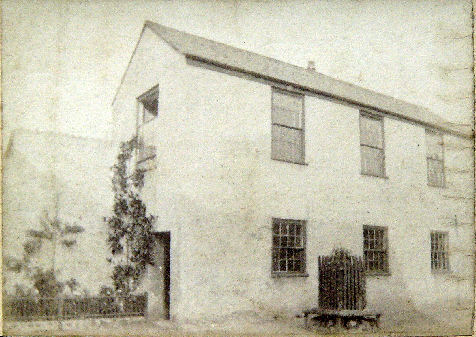 |
 |
GEORGE MILDON - FAMILY HISTORY
George Mildon was born in 1849 to parents John and Ann (nee Littlejohn) in the parish of St Thomas in Devon. The Mildon name is traceable to a manor west of Oakford, Devon, which was once the property of Queen Editta (Queen Edith to Edward the Confessor). The Anglo-Saxon name of the manor was Mildedona. There are still two farms by the names of East and West Mildon within the area of the original manor.
George's parents were of humble, rural origin. As a young married man, his father John Mildon was an agricultural labourer and lived in a cottage at Long Down near Alphington, Devonshire, probably working on the farm of the same name. The greater number of young rural men with varying degrees of education were employed in this way.
At the time of the birth of his youngest son George in 1849 John was working as a labourer at Stoodleigh in Devon and by 1861 he was at Greengate in the Parish of Uplowman also in Devon. As he grew older, he became a gardener. Probably not of flower gardens, or Pleasure Gardens as they were known, that were the preserve of the independent wealthy, but of the necessary produce gardens or allotments, usually of large extent, growing seasonable vegetables for the households year round. With retirement came more leisurely employment as a shopkeeper, probably in Uplowman, as he still lived at Greengate.
The first sightings of George after his birth are in the censuses of 1851 when he is just a small child, and 1861 when he is 11, when he is noted as a Scholar, possibly at St Peters in Uplowman where there may have been a church school, or at Uplowman School just a short walking distance from his home at Green Gate.
The first sightings of George after his birth are in the censuses of 1851 when he is just a small child, and 1861 when he is 11, when he is noted as a Scholar, possibly at St Peters in Uplowman where there may have been a church school, or at Uplowman School just a short walking distance from his home at Green Gate.
George is now lost sight of for 3 years, When he reappears in 1864 and again in 1868, aged 15 and 18 years old respectively, we read glowing testimonials as to his character: ‘…steady,
industrious and trustworthy….'. (Rev. Charles Sandford Bere, Tiverton). The Reverend Bere was the Vicar of Uplowman at St Peters for many years. ‘Of his character and excellent conduct it is impossible for me to speak to highly.' (Rev Canon Edward Girdlestone, Bristol). From which it is possible to glean that he may have had a secondary or upper education in Gloucestershire after which he then moved directly to teaching.
By the middle of 1870 George had taught for 2 ¼ years at Howell's Endowed School in Launceston when he sought to move from there to a position in France to teach English, but also with a view to improve his own knowledge of the French language. The Principal at Howell's, Mr R Reed, provided George with another reference to a prospective employer in France.
By July, he is in Guines in the Pas de Calais region of France. By now he is a young man of 21 who has clearly in the previous years improved not only his education but also himself and his station in life. Unfortunately the Franco-Prussian War interrupted what may have been a longer stay, the school not being able to retain its pupils on its account, and by December he is forced to leave France accompanied by another excellent reference from its Principal M. Bertin Popirul.
On returning to England in early 1871 he obtained a position at Spring Hill, a school near Southampton operated under its Principal the Rev. J L Carrick. It provided an education conducted on the principles of the Church of England and gave a Classical and General Education for the Sons of Gentleman. The fees were scaled according to the age of the pupils and ranged from 50 to 70 guineas per annum. As an aside, it was a school that provided access to ‘Good Sea Bathing', an activity that appealed to him as he was a strong swimmer.
His next posting was at Friends School, a Quaker establishment in Kendal, Cumbria, but from where, after 18 months, he took his leave, once again carrying a most satisfactory testimonial .This time he is embarking on an independent career as the owner of his own school. He bought a school as a going concern in Alcombe, Somerset and opened it on April 13, 1874, enrolling 15 pupils through that month including one adult student, Mr Izard, a private pupil, who was preparing for the Civil Service.
The school had been bought from Francis R Ransome, a middle-aged man of about 40, and his wife Ann. Mr Ransome was also a Member of the College of Preceptors. The school had an Assistant Master, Thomas Kemm and had a household staff of two. It boarded about 6 pupils including Francis Ransome junior and would have taken a number of day pupils as well. It is not known if George retained Mr Kemm.
Less than a week after opening the school George Mildon travelled back to his home village of Uplowman in Devonshire where he married Alice Frankpitt, the only daughter of Richard and Alice Frankpitt, Richard Frankpitt was a farmer with 80 acres not far from Uplowman. Ten years earlier his occupation was described as a Hide, an indication that he was a skilled farm worker, so he had improved his status somewhat.
George had probably known Alice from his youth. He would almost certainly have known her as one of the church of St Peter's congregation. She was about four years his senior. With his constant travelling and working at some distance from Uplowman after 1868 they would not have had a great deal of time together. In the manner of the times George would not have married until he was in a position to settle and support a wife and their expected children.
From the lowly status as the son of a farm labourer with seemingly slight prospects of social improvement at his birth, in less than 20 years George Mildon had raised himself, with a clear eye and a fair degree of ambition, to an educational standard far beyond his former social peers, and within a further five years his social standing had increased immeasurably. It is almost certain that his abilities had been detected at an early age and that he received sponsorship from outside his family, quite possibly through the original efforts of the Rev. C S Bere who remained a constant figure in his life almost until he left for New Zealand.
The next 20 years of the school from 1874 until 1894 are documented only by the entrances and departures of the 336 pupils in the school Register, an illuminated address from the boys on the occasion of the Principal's 39th birthday, and some correspondence from the Bishop's Palace at Wells, the Bishop being The Right Rev. and The Right Hon. Lord A C Hervey D.D., otherwise styled as Arthur Bath and Wells.
There had always been a strong church element in George's life and it was an influence on how he ordered his life. His activities at the Chapel in Alcombe led the parishioners in early October 1892 to petition him to receive a Lay Licence so he could provide services at the Chapel.
The licence was granted in early November.
Without a school diary and with no personal correspondence of this time there is nothing available to piece together events around the school and village, and only baptismal certificates keep us in touch with the growing Mildon family: Alice Ann in 1875; Percy George in 1879; Maud Mary in 1881; Francis in 1884; Dorothy Kate in 1888; and Margaret Olive in 1891. There was another son, Richard, born in 1886 but he died in 1887 at about 18 months. A number of photographs of the family were taken as they grew. Also, one photo of the school building and one of the schoolboys and the Mildon family together was taken about 1890. In 1891 the eldest girl, Alice, was boarding at a school for girls, Edgehill College in Bideford. Alice was a talented musician.
She sang and played the piano and for a time before 1894 she was the organist at St George's in Dunster.
In 1949 a series of letters appeared in the Tiverton Free Press. (part of which are printed at the bottom of this article). They were prompted by a brief mention in the paper of the school in an article about a possible new school for Alcombe. A stream of letters followed from Old Boys of the Mildon school, pushing away the mists of time to give us glimpses of the school, the methods of schooling used and memories of events that help to shape our understanding of the character of the school and of George Mildon.
It was George's health in the mid 1890s that brought about the decision to leave England for a better climate. His doctor advised him that he was suffering from angina and recommended a change. He had a number of options of which South Africa and New Zealand were the most seriously considered. It is not known why he chose New Zealand.
Before leaving Alcombe and Dunster a farewell function was held in the Luttrell Arms in Dunster. There a number of speeches made and there were presentations of gifts, and George's successor Mr William H Culverwell, an Old Boy of the school from before George Mildon's time, was wished the best of luck. The whole affair was reported in the West Somerset Free Press.
Note: William Culverwell's brother was Ebenezer Culverwell who attended Alcombe School when George was there. He was born in 1862, in Chicago, Illinois USA. He was 12 when he started at Alcombe School in 1874. Prior to that he was living at home in Dunster. His mother was Ellen L Culverwell who, in 1871, was the proprietor of a Ladies Seminary at Dunster, where in 1871 there were 11 young women aged from 11 to 20.
On August the 25th 1894 the family of eight, with their baggage, including a piano, embarked on the SS Tongariro, at Plymouth and left for New Zealand travelling Second Saloon. The ship was a steamer but had auxiliary sails. After stops at Tenerife, Capetown and Hobart, the ship arrived in Wellington on October the 10th .
The journey to New Zealand was not without its joys. Alice, the eldest daughter was smitten by the ship's Third Officer. They eventually married in 1898 and had two daughters.
Without a place to stay immediately the family booked into a boarding house on Plimmer's Steps and George set forth to find a farm to buy. His travels eventually took him to the borough of Palmerston North, about 90 miles north of Wellington on the western side of the lower part of the North Island. There, in the district of Kairanga, 5 miles to the west of Palmerston North he found something that suited him; one hundred and fifty acres of cleared former bushland with a large house already built. It was very swampy country and prone to regular flooding,
and the roughly grassed land punctuated by gaunt, burned and blackened tree stumps protruding out of the ground lent no beauty to the wide flat expanse of the surrounding countryside.
It seemed scarcely the kind of country that a man would occupy for the sake of his health.
Until they could take possession he moved his family up to Palmerston North and rented a house. It was a place remembered for its smoking chimneys and fleas. When he brought his family out to see his acquisition the sight reduced his eldest daughter Alice to tears. The difference between this and the green fields, hedgerows and picturesque countryside of Somerset was too much of a shock. They moved in just in time for the New Year, 1895. The younger daughters were enrolled at the local school, just walking distance across a paddock, Alice and Mary remained
at home, as did Percy who by now was16, he was to help his father on the farm, a future he regarded with distaste as he was a reluctant farmer.
In 1903, the Vicar of the Parish in Palmerston North, the Rev. Charles Harper petitioned the Frederick the Bishop of Wellington to issue a Lay Licence for George to read and preach in the District. The licence was issued and George was now allowed to conduct services for the country people in the nearby school building. He taught Sunday School, and led the subscription for a harmonium which still exists.
George did not have long to enjoy his new life. After just 10 years, during which time he learned to be a farmer in some difficult country and immersed himself in local education and church life, in 1904 he suffered kidney failure, and because there was no treatment he died aged just 54.
In 1905, Percy married the socialite daughter of a wealthy Auckland businessman. They had two children.
Under Percy the farm was developed by the work of employees and eventually, his sons into a wealthy productive unit. Percy remained a gentleman farmer until his death in 1959. The farm is no longer in the family but the homestead with 3 acres of the ground George and Alice brought their family too, is still lived in by the writer, a great-grandson, Richard Mildon and his wife Geraldine. George and Alice's gravestone is in their garden.
With the passing of Percy in 1959 the knowledge in the family of the whereabouts of the school in Alcombe died too.
It remained a mystery until May 2007 when after 6 years of discovery and detective work, it was found again by the combined efforts of many people both in New Zealand and in Somerset, who through their communication have not only become good friends but have now completed a circle.
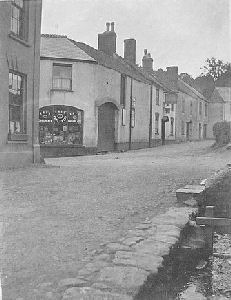 |
||
'On the way to school', taken 1938 by Percy Mildon |
The Mildons home in New Zealand 1894 ROLL MOUSE OVER TO SEE IT NOW |
George Mildons' family 1894 |
printed in 1949 under
'Recollections from Old Boys of Mr.Mildons School Alcombe'
One day I caught a rabbit up in the orchard with a bit of string, and this was later found out by Mr.Mildon. He took all of us boarders up to the place where the rabbit was caught, and asked who had done it. I owned up, was reprimanded, and warned never to do such a thing again. But Mr.Mildon had the rabbit, and presumably enjoyed it! Another thing
Mr Mildon taught me was to play draughts. I still enjoy my evening game, having retired from farming many years ago. Robert Heywood, the Cross, Minehead.
Miss.E.Batting writes from London, with a reminder that her brothers, Edward, Walter and the late Guy Batting - sons of the late Mr.John Batting of Minehead - all went to Mildon's School. Both Edward and Walter are in South Africa. Edward, who is getting on in years, still loves a bit of fishing and is living near East London, South Africa. Walter, who is
practically retired, has a house about 20miles from Durban. Guy Batting who was engaged during the last war, and before, on salvage work for the Liverpool and Glasgow Salvage Association, was killed by an enemy land-mine during an air raid on Wallasey, where he lived, while he was helping A.R.P. wardens.
A word frequently used by the school pupils was 'cave' pronounced like 'kayvee' with the accent on the first syllable. It was spoken almost in a whisper and rapidly, as the headmasters footsteps were heard on the stairs leading to the schoolroom. It is interesting to find this word in the little oxford dictionary, where it is defined as "look out'! warning of approach of master" .
Handwriting and spelling received special attention with excellent results. Some of the Minehead boys had dinner with the boarders in Mr.Mildon's house, and still remember the ever welcome apple tart with brown sugar and milk.
The headmaster himself, a good athlete, was keen on games and proud of the achievements of his boys. A senior pupil named Davis, of Watchet, who became a preaching evangelist, was our star centre-forward at football. This hefty player would bore his way through all the opposition, sometimes forcing both ball and defenders through the posts. Another fine all rounder was Horace Gliddon. Vicery of Carhampton (Dicky-Vic) was probably the fastest short distance runner in the neighbourhood. I believe he was usually the selected 'hare' in our periodical paperchases.
Mr Mildon was a good swimmer, he and the assistant-master, Mr.Hilton were fond of swimming out a considerable distance in the channel, each carrying a small boy on his back.
a very stern, almost fierce looking personality, and the boyhs would hardly dare to take any liberties with him. Mr Rawle, who recalls with pride that he was second boy in the school when he left, recalls that they had a good deal of homework to do. Some of the dayboys, farmers sons, who had to work after they got home, sometimes had little chance to do their home lessons and Mr.Rawle remembers helping certain among them to get their work done. We used to have Civil Service 'tots' to do. There were pages of them and we were given so much time to add up as many as we could in that time.
on the West Coast of Africa for an important Bristol company. He was usually away three years and back for one year. Being cousins, we saw a lot of these boys, but after Captain Howes retirement the sons took up fruit farming on their own in California. All have retired there, as has a younger son, Frank Howe.
My brother was apprenticed with Mr.James Langdon of Minehead as a builder for five years and made a big success of it. Afterwards becoming a house builder of some repute. He died last year (1948) but the business is still being carried on by his son, John, as James Knight and sons, Cardiff. My brother who retired some 20yrs ago always considered that his old schoolmaster coached him so well, whilst there. that estimates ect. were easily arrived at without loss.
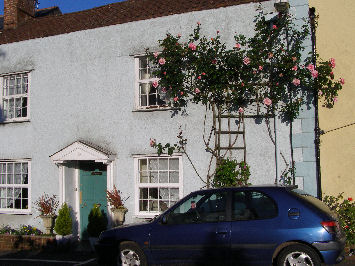
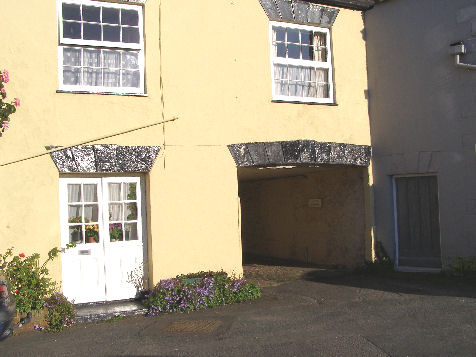
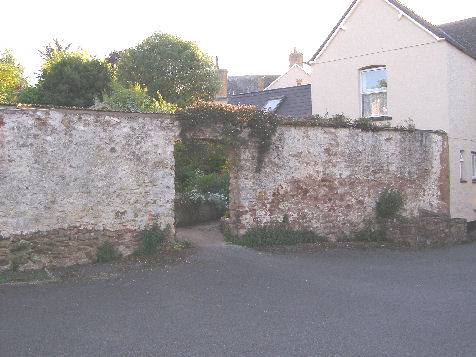
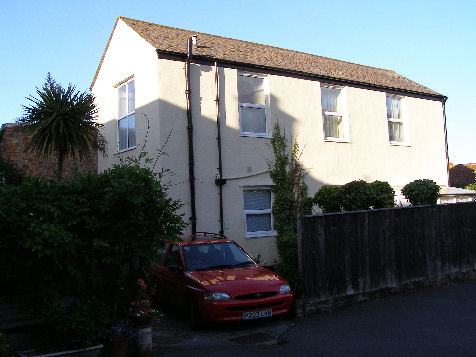
go through the arch to see.........
Turn to your left and you will see, what once was..................
